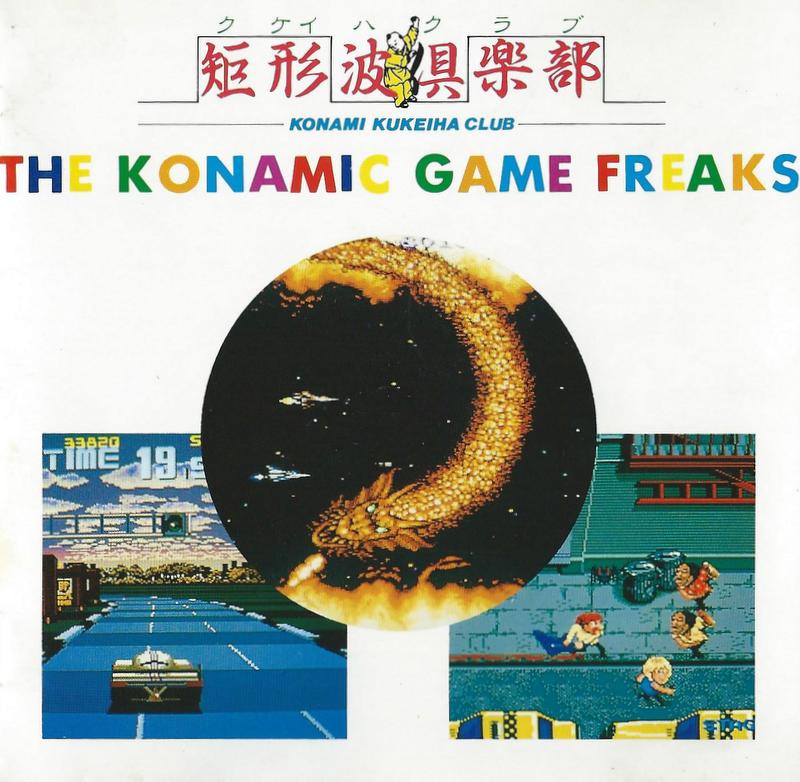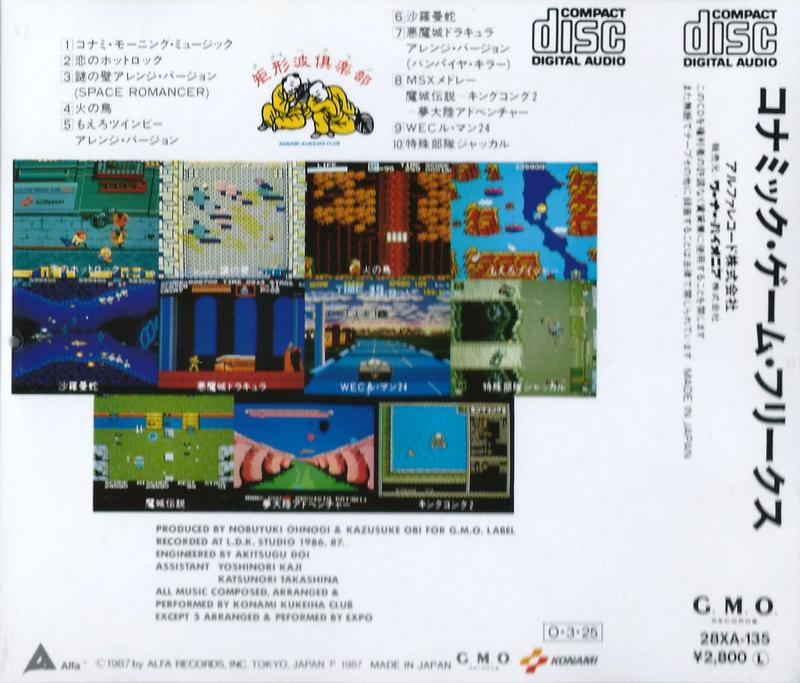Game Music Revue: The Konamic Game Freaks
 Konamic Game Freaks (Compilation)
Konamic Game Freaks (Compilation)
- Credited Composer: Konami Kukeiha Club
- Released: March 25, 1987
- Label: GMO/Alfa
- VGMdb Information Page
I think that the “golden age” of game music soundtracks in Japan was 1984 to about 1990. It was during this time that just about any and every game company was pumping out game music albums nearly as often as they were the games themselves. Sometimes these would be full-length soundtracks, as was the case with games like Wizardry and Dragon’s Quest, but more often than not these releases took the form of compilation albums that highlighted the best music a company had to offer.
Game studios went about these in a variety of ways, but the most common format I’ve come across featured a combination of original game music mixed in with remixes and arranged versions. These are my favorites, and are really what give many of these classics albums real value in my opinion. Original game music is great, but if you want to hear that you can always just play the game. These remixes are the real rarities, and frequently serve as insight as to what the composers had in mind when they were creating the music, as they were free of any hardware limitations when creating them.
Konamic Game Freaks, one of many Konami compilations put out by GMO records, features four such arranged versions. The first is a re-imagining of the theme music to Nazo No Kabe, a breakout clone that never made it to the states (although it was released in PAL regions as Crackout). It’s decent, but boring, and without any nostalgia tied to the original music, to me it just sounds like some sub-standard 80s instrumental that wouldn’t be out of place in the end credits of a made-for-TV movie starring the dad from Family Ties.

Things pick up with the second remix, a take on the theme to Moreo Twinbee, which was released in the states as Stinger. This one is an improvement over the first track, and matches the fun, upbeat tone of the game from which it came. It really kicks into overdrive about halfway through too, when a killer synth-sax solo kicks in and the whole thing breaks down into a collage of gameplay audio before starting back up at a faster speed with more electronic/gameplay audio. It’s a strange one. I love it.
The last remix is the best though, a downright awesome take on the theme to Akumaju Dracula, AKA Castlevania. It totally goes for a spooky vibe, complete with synthesized organ sounds and creepy sound effects, and it’s a great interpretation. All it’s missing is a theremin.
While the arranged versions are interesting and are clearly the album highlights, the majority of The Konamic Game Freaks is original music. Thankfully, most of it is quite good, and features music from games I would never have heard of otherwise, such as Hi No Tori and WEC Le Mans 24 .
Of the original game music tracks, there are two easy standouts; the music from the classics Salamander (AKA Lifeforce) and Tokushu Butai Jackal (just Jackal in the states). These both, Salamander especially, are easy highlights for not just this album, but game music from that era as a whole. Both are perfect examples of the manic, high-energy and frantic tunes that frequently served to get gamers’ blood (and quarters) pumping as they laid waste to countless enemies.
Both tracks also serve as great soundtracks to any morning jog.
But the most interesting cut on this record isn’t a remix, or a theme to a beloved classic. It’s the track for the game Koi No Hot Rock, which was released in American arcades as Rock ‘n’ Rage.
I never heard of this game before buying this CD, but from what I’ve seen from clips online, it looks like a top-down arcade shooter in the vein of Ikari Warriors. Those were a dime a dozen back in the 80s, but this one stands out for being oddly musically-themed, instead of a gun, your character packs a guitar and plays music to slay his enemies while searching for the kidnapped lead singer of his band.
Most games from this era didn’t have a lot of original music – just simple loops that when combined would total about seven or eight minutes. As Koi No Hot Rock is a music-themed game, it has considerably more music, 14 minutes in total. And some of it is nuts. It starts out pretty normal. Synthesizer guitar solos abound, all very fitting for a soundtrack to a game about a jukebox hero with stars in his eyes. But then, wait, is that John Lennon’s “Woman?” And hold on a second, is that “Rock Me Amadeus” followed by “Like A Virgin?” “Born in the USA?” What the hell is that doing here?!
Yes, this game just straight up steals popular songs for use in the game. All instances are short, typically just a few seconds, but they’re noticeable, that’s for sure. I don’t believe that the original songwriters or performers are even credited, definitely not the kind of thing that developers could get away with now.
Although I guess crediting songwriters for stolen songs is a bit much to ask, as the disc’s liner notes don’t even credit the songwriters for the original music. The entire album is credited to “Konami Kukeiha Club,” so legendary composers such as Michiru Yamane (the woman behind the music to Castlevania) are left anonymous. I wonder why.
Konamic Game Freaks was originally released on vinyl, CD and tape formats when it first came out in 1987. Since then it’s been re-released a few times on CD – so if you’re interested it’s actually not that hard to find online or in used CD shops in Japan. I regularly stumble across it when I’m out shopping in Nakano or Akihabara. In person I typically see the CD on sale for anywhere between $20 and $40, and online it tends to sell for closer to $40, ditto for the LP. Considering how much new CDs cost in Japan ($30+) that’s actually not that bad a price.
Not the best game music album in my collection, but certainly the only one with chiptune Madonna, so it definitely has a special place in my heart.
Leave a Reply